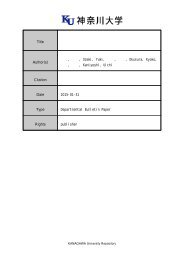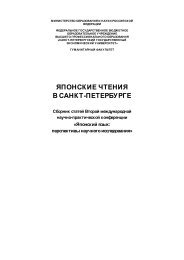to Learners with Special Educational Needs
e-textbook SEN
e-textbook SEN
You also want an ePaper? Increase the reach of your titles
YUMPU automatically turns print PDFs into web optimized ePapers that Google loves.
Pokrivčáková, S. et al. (2015). Teaching Foreign Languages <strong>to</strong> <strong>Learners</strong> <strong>with</strong> <strong>Special</strong> <strong>Educational</strong> <strong>Needs</strong>:<br />
e-textbook for foreign language teachers. Nitra: Constantine the Philosopher University. 128 p.<br />
ISBN 978-80-558-0941-0<br />
practise all skills, especially the problem making skills where the students face difficulties and<br />
problems.<br />
<strong>Educational</strong> games are one of the possible ways how <strong>to</strong> motivate and improve students´<br />
writing skills. There are plenty of activities and games suitable for dysgraphia students, but the<br />
problem that could occur is teachers´ disability <strong>to</strong> prepare and use such games and activities. As<br />
we have already mentioned, teachers should have been provided <strong>with</strong> several seminars or<br />
lectures dealing <strong>with</strong> the preparation of materials for students <strong>with</strong> dysgraphia.<br />
There are different ways how teachers can help children <strong>with</strong> learning and <strong>to</strong> succeed in<br />
school. Here are some suggestions <strong>to</strong> discuss <strong>with</strong> the school, schools psychologist or specialist<br />
as possible options for students. We summed up several hints of accommodations,<br />
modifications, and techniques <strong>to</strong> assist the student <strong>with</strong> dysgraphia. We analysed these<br />
problems and summarized them in<strong>to</strong> the following areas and we suggested how <strong>to</strong> overcome<br />
them. Presentation modifications, response modifications and other following modifications<br />
allow and recommend students <strong>to</strong>:<br />
Presentation<br />
of a new<br />
grammar<br />
Response<br />
Timing<br />
Setting<br />
1. Learn content from songs, movies, audio books, videos and digital media<br />
2. Listen <strong>to</strong> audio recordings instead of reading text<br />
3. Have another student share class notes <strong>with</strong><br />
4. Work <strong>with</strong> fewer materials and exercises<br />
5. Have a written list of instructions how <strong>to</strong> fulfil the task<br />
6. Record a lesson, instead of taking notes<br />
7. Have an outline of a lesson and worksheets <strong>to</strong> copy less from the board<br />
8. Use information gap activities, problem solving activities <strong>to</strong> develop<br />
critical thinking and open-ended s<strong>to</strong>ries <strong>to</strong> develop imagination and<br />
creativity<br />
9. Use visual presentations and IT technology<br />
10. Play special games <strong>to</strong> develop the range of attention<br />
11. Practise writing by copying a short phrases or articles<br />
12. Be patient and positive when practicing handwriting.<br />
13. Use sensory <strong>to</strong>ols-flashcards, playing cards, pictures, charts, posters, <strong>to</strong>ol<br />
which they can catch and <strong>to</strong>uch<br />
1. Give responses in a oral/recorded or written form<br />
2. Use a dictionary<br />
3. Learn from webpages where he can find exercises in both forms-written<br />
and spoken/recorded<br />
4. Dictate answers <strong>to</strong> a scribe<br />
5. Capture responses on an audio recorder<br />
6. Use a word processor <strong>to</strong> type notes or give responses in class<br />
7. Complete writing activities in small steps<br />
8. Have a “proofreader” <strong>to</strong> look for errors<br />
1. Take extra time for writing tasks.<br />
2. Have extra time <strong>to</strong> process oral information<br />
3. Take frequent breaks after completing a task<br />
4. Repeat the words several times and copy more times the same words<br />
1. Work or take a test in a different setting, such as a quiet room <strong>with</strong> few<br />
distractions<br />
2. Sit where he learns best (near the teacher)<br />
3. Cooperate <strong>with</strong> partner while doing the task<br />
4. Take a test in small group setting<br />
5. Use a lot of colours, highlighters and colourful felt-tip pen <strong>to</strong> mark the text<br />
and important facts.<br />
65






